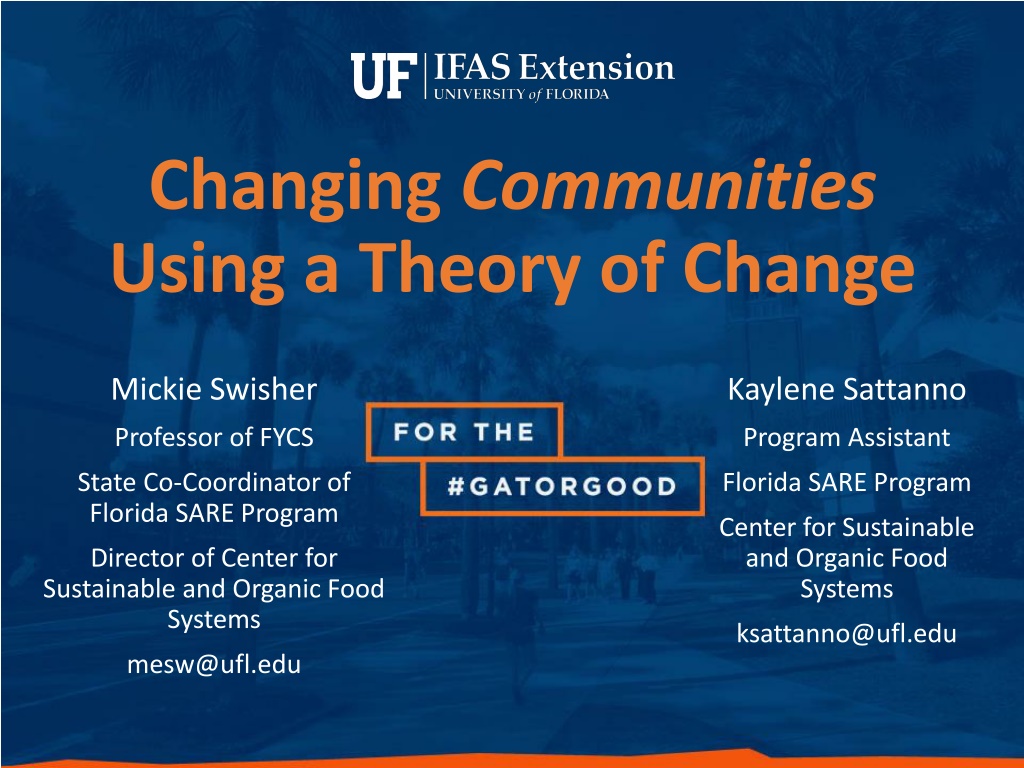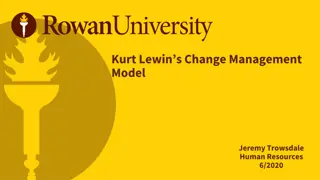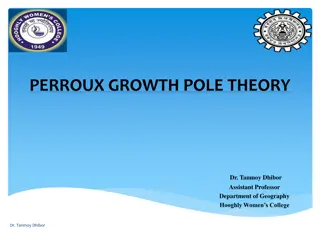Enhancing Community Systems Through a Theory of Change
Explore how utilizing a theory of change can empower community systems to achieve positive outcomes by establishing objectives, identifying partners, and selecting indicators for monitoring and evaluation. Learn why community systems are vital for quality of life and how they encompass resources, organizations, and connections within a locale. Discover the relevance of a holistic food system model to extension program areas, such as nutrition education, small farms, and public policy analysis.
Download Presentation

Please find below an Image/Link to download the presentation.
The content on the website is provided AS IS for your information and personal use only. It may not be sold, licensed, or shared on other websites without obtaining consent from the author. Download presentation by click this link. If you encounter any issues during the download, it is possible that the publisher has removed the file from their server.
E N D
Presentation Transcript
Changing Communities Using a Theory of Change Mickie Swisher Kaylene Sattanno Professor of FYCS Program Assistant State Co-Coordinator of Florida SARE Program Florida SARE Program Center for Sustainable and Organic Food Systems Director of Center for Sustainable and Organic Food Systems ksattanno@ufl.edu mesw@ufl.edu
Training Objectives After completing this training you will be able to: 1. Use a theory of change to develop a strategy to improve the outcomes of community systems 2. Establish objectives for a community-based program to achieve change in performance of community systems 3. Identify community partners you need to work with to implement the objectives of your program 4. Select community-level indicators you can use to monitor and evaluate your program impacts
Community Systems Community systems consist of the resources, the public and private organizations that manage the resources, and the linkages or connections between the managers, stakeholders and users of these resources in a given locale The scale may be from small (a neighborhood) to a town or city to a large metropolitan area which includes the surrounding agricultural areas
Why Community Systems? Community systems fulfill functions critical to the quality of life for people in any community Provide food Educate our children Maintain & protect natural resources Create sustainable economic growth Improve health
Holistic Food System Model Holistic food system model. Source: adapted from Combs et al., 1996.
Relevance to Extension Program Areas FYCS Farm to School Money Management Nutrition Education School & Community Gardens ANR Crop & Livestock Production Small Farms Water & Energy Conservation Agri- and Ecotourism CRD Business Retention & Development Food Policy Council Market Analysis Public Policy Analysis
Holistic Food System Model Holistic food system model. Source: adapted from Combs et al., 1996.
What is a Theory of Change? An explanation usually in graphic form of how and why a complex change process will succeed in a specific set of circumstances It is both a process and a product As a process the ToC works backwards from specific outcomes to identify the players, actions and resources needed to achieve the desired outcomes As a product the ToC is a roadmap that shows who needs to do what to achieve the desired outcomes
How Do You Use a ToC? To identify specific, achievable outcomes rather than general goals or objectives To identify partners needed to achieve the outcomes To get clarity and agreement about what needs to happen and who does what To determine the specific interventions or actions (programs) that you will implement To keep all partners on track and on time To provide a basis for evaluation
Theories and a Theory of Change Theories of behavioral change are general models that explain why people do or do not change their behavior Theories are universal they are not specific to any context or to any specific behavioral change Theories do not indicate specific actions or interventions needed to achieve a specific change But theories do form the science-based causal logic for a ToC
Theory of Planned Behavior Individual Decision-Making Behavioral beliefs Attitude before behavior Evaluations of behavioral outcomes Attitude before behavior Normative beliefs Behavioral Behavioral Behavioral intention intention intention Subjective norm Subjective norm Behavior Motivation to comply Control beliefs Perceived behavioral control control Perceived behavioral Evaluations of behavioral outcomes
Theory of Planned Behavior Individual Decision-Making Summative or Direct Constructs Attitude toward behavior Primary or Indirect Constructs Definition Overall evaluation of the behavior Behavioral belief Belief that behavioral performance is associated with certain attributes or outcomes Value attached to a behavioral outcome or attribute Evaluation Subjective norm Belief about whether most people approve or disapprove of the behavior Belief about whether each referent approves or disapproves of the behavior Motivation to do what each referent thinks Normative belief Motivation to comply Perceived behavioral control Overall measure of perceived control over the behavior Control Beliefs Perceived likelihood of occurrence of each facilitating or constraining condition Perceived effect of each condition in making behavioral performance difficult or easy Perceived likelihood of performing the behavior Perceived Power Behavioral intention
Social Support Theory Decisions as a Social Process Social Networks Density Homogeneity Geographic Dispersion Directionality Social Support Emotional Instrumental Informational Appraisal Stressors Individual Coping Resources Problem solving abilities Access to new contacts & information Perceived control Community Resources Community-based organizations Community-based expertise Coping & Well-Being Behavioral Outcomes Behavioral assessment Preventive behaviors Response behaviors
Social Support Theory Decisions as a Social Process Summative Construct Primary Construct Definition Social Network Density Extent to which network members know and interact with each other Homogeneity Extent to which network members are demographically similar Dispersion Extent to which network members live in close proximity Directionality Extent to which members of the network share equal power and influence Social Support Emotional Expressions of empathy, love, trust and caring Instrumental Tangible aid and service Informational Advice, suggestions and information Appraisal Information that is useful for self-evaluation and regulation Individual Coping Resources Problem-solving abilities Degree to which an individual can use resources to solve problems Access to new contacts & information Degree to which an individual can acquire new problem-solving information Perceived control Overall measure of perceived control over the behavior
Socio-Ecological Theory Individual Interpersonal & Group Knowledge, attitudes, behaviors, self- concept, skills & life history Institutional Formal and informal social networks and social support systems -- including family, work, and friendship networks Community Institutions and organizations that operate under formal and informal rules and regulations Policy Relationships among formal and informal organizations, institutions and networks Local, state and national laws, policies, and regulations
Examples of Goals for a ToC Keep land in agriculture and foster agriculturally based economic development Improve access to healthy & affordable food Improve the health of the population Engage youth with food systems Create a food system friendly policy and regulatory involvement Create a food system literate public and private sector
Community Food System Theory of Change
Existing Condition Reinforcing Factors Capacity Building Objectives Severe and growing incidence of nutritionally related chronic illnesses, especially among poor and minority populations Cost of and access to fresh fruits and vegetables (FFV) is prohibitive for the poor Mobilize public and private sector community leaders to support action to address identified issues Agricultural production costs, competition, and emerging pests and diseases are rising Agricultural land use, number of farms, and profitability of farms is decreasing Formation of public-private partnerships to develop address specific components of the related issues Farmers face increasing restrictions on use of natural resources, especially water Job growth is stagnant and/or jobs created are part-time, seasonal, low- paying and offer few benefits Secure public or private funding to support and maintain the partnerships through early stages of interventions to create change Increased role of low-paying, part-time and seasonal employment increases need for and cost of social support programs Needed Interventions Outputs Key partners are identified and an action plan identifying needed interventions is created with responsibilities assigned to all partners Develop alternative sales points for fresh fruits and vegetables and facilitate transportation to them Create alternatives to conventional market chains for farmers Social media and citizen forums are used to educate the public and secure community support for the action plan Identify alternative crops and enterprises All partners collaborate to secure funding to support needed interventions Generate high-paying permanent jobs through growth in the food sector
Intermediate Objectives: Implementing Interventions Long Term Objectives: Getting to the Goals Outputs from Initial Objectives Are Implemented Best models for alternative venues for FFV purchases are identified and implemented Increased purchases of FFV at new or enhanced venues in disadvantaged neighborhoods Short Term Objectives : Finding Out What Works One or more facilities to support access to high value market chains are operational and on their way to fiscal success Improved diet and related health outcomes are reported in target neighborhoods Pilot tests of new venues for FFV purchases are conducted in disadvantaged neighborhoods Selected crops and products generate costs of production and productivity necessary for profitability Farmers and local organizations create at least one facility or organization to support access to high value market chains Increased number of farms use facilities to gain access to high value market chains Training program is implemented and at least one cohort of students graduates Alternative crops and products are tested with area farmers and agriculturally related businesses Alternative crops and products achieve profitable market penetration Partner organizations team with public school system, community colleges and private sector educational institutions to create and fund training programs to prepare employees for permanent, good jobs in food and agriculture related businesses Community Level Changes = Achieving the Goals Increased good jobs are available in food and food related businesses Graduates of training program fill the positions created Reduced incidence of nutritionally related chronic illnesses Enhanced agricultural productivity and profitability Increased jobs, income, and revenues
Socio-Ecological Model of Change Individual Level Outcomes Behavioral Outcomes Result From: Individual rational choices based on knowledge and risk/benefit assessment Assumptions Behavioral choices are reasonably available to the individual Individual understands the seriousness of the risks associated with undesirable behaviors and the potential benefits of alternative behaviors Individual has the knowledge & skills needed to change behavior Individual assesses his/her ability to change behavior is within his/her control Examples of Outcomes Short-term: Pre-post test of nutrition knowledge, individual Intermediate-term: Adoption of new crop or practice; farm Long-term: New agricultural businesses are started; individual
Socio-Ecological Model of Change Intermediate Level Outcomes Behavioral Outcomes Result From: A combination of individual desire to change behavior and changes in the social environment of the individual Assumptions Behavioral choices are reasonably available to the individual and the social networks of which s/he is a member Individuals copy and learn behavior from significant individuals and groups that influence knowledge, skills, perceptions, and norms of desirable behaviors Behavioral change is more likely and rapid when group norms reinforce individual intentions to change behavior Support networks play a critical role in helping the individual achieve and maintain behavioral change Examples of Outcomes Short-term: Establish support groups for those wanting to change diet; group Intermediate-term: Farmers form cooperative to market new crops; group Long-term: Ag policy council is developed to promote agricultural expansion; group
Socio-Ecological Model of Change Community Level Outcomes Behavioral Outcomes Result From: A combination of individual decisions, changes in the social environment, and facilitating or enabling conditions in the community Assumptions External barriers make behavioral choices reasonably available to individuals or groups Reducing barriers to behavioral change is a critical enabling condition for behavioral change Reducing barriers requires mobilizing resources internal and external to the community (community engagement) Examples of Outcomes Short-term: County institutes policy to eliminate low-quality foods in schools; community Intermediate-term: Increased economic revenues and employment from coop; community Long-term: County rezones to protect agricultural land use; community
Objectives Based on a Theory of Change
S.M.A.R.T. Objectives Specific Measurable with measurement Achievable Relevant Time-oriented
S.M.A.R.T. Objectives Worksheet SPECIFIC What will you achieve? Conduct pilot tests of adding FFV to existing sales venues (such as convenience stores) in disadvantaged communities How will you know when it is done? Potential sites for new venues will be identified Installation of chilling equipment will be completed if needed System to track sales is installed Produce delivery system is tested and functions Periodic evaluations are completed for first year of operation
S.M.A.R.T. Objectives Worksheet MEASUREABLE WITH MEASUREMENT If applicable, what are the quantity & quality expectations? At least six or eight sites, preferably ten or twelve, are established At least sixty percent of sites continue into year 2 of test At least 90% of deliveries are made on time and are of the quality needed Sales increase at least 50% over the course of Year 1 If applicable, what are the frequency expectations? All sites are visited monthly to collect data and discuss any emerging issues with operator If applicable, what are the cost expectations? Salary and operating costs of delivery trucks Pay data collectors Cost of chilling equipment if not already available in the venue May need to upgrade sales tracking system
S.M.A.R.T. Objectives Worksheet ACHIEVABLE What are the knowledge, skills, abilities and experience needed to achieve the objective? Experienced collaborator Qualified data collector Reliable FFV providers Are there available resources to achieve the objective? If so, what are they? Dependent on grant funding Are there any time factor or environmental constraints that need to be considered? If so, what are they? Seasonal availability of locally produced FFV
S.M.A.R.T. Objectives Worksheet RELEVANT Which of UF s strategic priority areas does it address? Enhanced profitability and productivity of agriculture Improved nutrition and health Which department or supervisor objective does it support? County health department goals of reduced morbidity and mortality from chronic disease County Board of Commissioners goal to reduce expenditures on health and welfare and increase revenues Regional Economic Development Council goal to increase business retention in the county Why are you doing this? Many attempts have been made to establish alternative sources of food for disadvantaged communities, including farmers markets, school gardens, and community gardens. The use of existing venues to get FFV into communities would significantly complement and enhance these efforts, potentially at lower cost over the long term.
S.M.A.R.T. Objectives Worksheet TIME-ORIENTED When does it need to be completed? Two years total, with an internal evaluation at the end of year 1
Collaborating for Community Food Systems Identifying Partners
Potential Partners Identify partners based on S.M.A.R.T. objectives
Valid Indicators to Show Impact Evaluation and Reporting
Examples of Capacity-Building Indicators Capacity Building Objectives Leaders of business, non-profit organizations and government organizations agree to participate in developing action plan Mobilize public and private sector community leaders to support action to address identified issues Team is organized and meets regularly, with progress reported through social media Formation of public-private partnerships to develop address specific components of the related issues Local government agencies and private organizations endorse resulting action plan Secure public or private funding to support and maintain the partnerships through early stages of interventions to create change Potential sources of funding are identified and grant-writing teams are developed to seek funding
Examples of Short-Term Indicators Short Term Objectives 10 test sites are established prior during the first year of implementation Pilot tests of new venues for FFV in disadvantaged neighborhoods One facility is established to create access to high value market chains Farmers and local organizations create at least one facility or organization to support access to high value market chains Funding for comprehensive program of crop and product testing is secured Alternative crops and products are tested with area farmers and agriculturally related businesses Partner organizations team with public school system, community colleges and private sector educational institutions to create and fund training programs to prepare employees for permanent, good jobs in food and agriculture related businesses A conference of potential partners for the training program is held and grant writing teams are established
Examples of Intermediate Indicators Intermediate Objectives Number of alternative food venues established Best models for alternative venues for FFV purchases are identified and implemented Number of food purchases at alternative food venues Sales generated from food items at alternative food venues One or more facilities to support access to high value market chains are operational and on their way to fiscal success Number of facilities supporting access to high value market chains Selected crops and products generate costs of production and productivity necessary for profitability Number of students completing training program % of graduates hired within six months of graduation Training program is implemented and at least one cohort of students graduates
Examples of Long-Term Indicators Long Term Objectives Improved diet and health outcomes in communities serviced by FFV venues compared to other similar communities Increased purchases of FFV at new or enhanced venues in disadvantaged neighborhoods Improved diet and related health outcomes are reported in target neighborhoods Increased numbers of non- traditional venues adopt FFV sales Number of food related businesses started Increased number of farms use facilities to gain access to high value market chains Number of food related jobs created Alternative crops and products achieve profitable market penetration Number of graduates of training program with jobs in food industry Increased good jobs are available in food and food related businesses Graduates of training program fill the positions created
Logic Models & ToC A ToC is like a logic model in reverse you start with the objectives and end up with the activities a good ToC leads pretty automatically to a good logic model It differs from the traditional logic model because it is based on a model or theory of change like the socio- ecological theory Our ToC in this training session focused specifically on community level changes We always get information from individuals or specific organizations, but the long term objectives are measurable at the community level
IRB Ethics of asking people questions: What constitutes human subject research? Why do we have federal and international standards covering human subject research? What is the IRB? When do we have to get IRB approval to ask people questions? What are the requirements for getting IRB permission to ask people questions? Why it takes so much time to develop an instrument for socio-economic research: Three key concepts: reliability, validity, explanatory power Why we have to test even "simple" instruments
References Combs, G. F., Jr., Welch, R. M., Duxbury, J. M., Uphoff, N. T., & Nesheim, M. C., (1996). Food-Based Approaches to Preventing Micronutrient Malnutrition: an International Research Agenda. Cornell International Institute for Food, Agriculture, and Development, Cornell University, Ithaca, NY. Glanz, K., Rimer, B. K., & Viswanath, K. (2008). Health Behavior and Health Education: Theory, Research and Practice (4th ed.). San Francisco, CA: Jossey-Bass.























